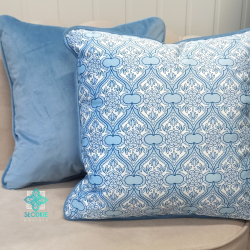Nowe produkty
Bestsellery
Popularne produkty
Blog
-
Jak udekorować wnętrze poduszkami ozdobnymi?
Opublikowany : 2023-11-01 | Kategorie : NowościDekorowanie wnętrza to prawdziwa sztuka tworzenia harmonijnej atmosfery i osobistego stylu. Jednym z najprostszych i jednocześnie efektownych sposobów na odświeżenie wnętrza są poduszki ozdobne
-
Twój Dom Pełen Świątecznego Uroku!
Opublikowany : 2023-10-31 | Kategorie : KolekcjeŚwięta to czas, aby dzielić się miłością i radością. Niech Twój dom będzie gotowy na te wyjątkowe chwile. Odwiedź nasz sklep i odkryj naszą nową kolekcję już teraz!
-
Zaczynamy!
Opublikowany : 2023-10-29 | Kategorie : NowościHistoria naszej marki, Sweet Pastels, to opowieść o pasji dwóch kobiet, które dzielą nie tylko imię Justyna, ale przede wszystkim miłość do tworzenia pięknych, oryginalnych dekoracji.
Ekskluzywne poduszki i poszewki dekoracyjne Sweet Pastels
Piękne poduszki dekoracyjne pełnią rolę biżuterii, która dopełnia aranżację pokoju dziennego, sypialni czy pokoju dla gości. Pozwalają wprowadzić do wnętrza wzory i kolory, dzięki którym wystrój nabiera charakteru. Sięgając po eleganckie poduszki dekoracyjne, warto pamiętać jednak o tym, że ogromne znaczenie ma nie tylko barwa tkaniny, z jakiej zostały uszyte, ale również jej jakość i tekstura. Z tego względu w asortymencie naszego sklepu znajdziesz przede wszystkim ekskluzywne poduszki dekoracyjne z weluru i atłasu, występujące w wielu kolorach i wzorach do wyboru. Możemy zaproponować Ci oryginalne poduszki ręcznie szyte w stylu hampton, wzorzyste czy w kwietne motywy. Łatwo też połączysz je z innymi tekstyliami z naszych kolekcji - z pledami, dekoracjami stołu czy pufami.
Dlaczego warto postawić na ekskluzywne poduszki dekoracyjne?
Wnętrze pozbawione dekoracji jest puste, bezosobowe, pozbawione charakteru. Za pomocą dodatków, w tym zwłaszcza dodatków tekstylnych, możesz ocieplić je, nadać mu konkretny styl i sprawić, że będzie bardziej eleganckie, nawet wytworne. Jeśli chcesz odświeżyć swoje aranżacje lub nadać im szyk, postaw na ekskluzywne poduszki, w różnych kształtach, kolorach i wzorach do wyboru. Poduszka dekoracyjna jest jednocześnie elementem wystroju praktycznym i ozdobnym. Pozwala w prosty sposób dodać aranżacji koloru. Nadal jednak należy dopasować ją do wystroju. Warto zwrócić też uwagę na jej jakość wykonania. Jeśli chcesz, aby eleganckie poszewki dekoracyjne prezentowały się nieskazitelnie nie tylko przez kilka pierwszych tygodni po zakupie, postaw na produkt wykonany z wysokogatunkowego materiału, tworzony z dbałością o każdy detal. Nasze ekskluzywne poszewki na poduszki nie pochodzą z kolekcji masowej. Większość dostępnych w sklepie modeli szyjemy na zamówienie. Możesz więc mieć pewność, że nie zobaczysz ich w mieszkaniu znajomych czy rodziny.
Jak wybrać modne poduszki do salonu?
Pokój dzienny jest pomieszczeniem, w którym luksusowe poduszki dekoracyjne odgrywają najważniejszą rolę. W końcu jest to wnętrze reprezentacyjne, służące do przyjmowania gości. Najlepszy wybór do takiej aranżacji stanowić będą ekskluzywne poduszki ozdobne, dopasowane do danego stylu wnętrzarskiego. Jeśli Twój salon jest urządzony nowocześnie, możesz bez obaw wybrać do niego ekskluzywne poduszki w stylu Hampton lub glamour. Dzięki nim aranżacja będzie prezentowała się wręcz luksusowo. Z kolei do salonu w stylu boho, shabby chic czy urban jungle możesz dopasować ponadczasowe poduszki z motywem florystycznym, który wprowadza do aranżacji element romantycznej natury. Pamiętaj również, że pokój dzienny powinien być przytulny, aby Twoi goście, ale też domownicy, dobrze się w nim czuli. Poduszki do salonu muszą być więc zadbane i przyjemne w dotyku. To między innymi dlatego nasze oryginalne poduszki dekoracyjne szyjemy głównie z tkaniny welurowej. Jej charakterystyczny, lekko lśniący meszek sprawia, że poszewka jest niezwykle miękka i gładka, a dodatkowo pięknie mieni się w różnym oświetleniu.
Oryginalne poduszki dekoracyjne w różnych kształtach do wyboru
Nasz sklep z poduszkami dekoracyjnymi może zaoferować Ci zarówno szeroki wybór wysokiej jakości poszewek na poduszki, jak i ciekawy wybór wypełnień w różnych kształtach do wyboru. Posiadamy nie tylko klasyczne poduszki w kształcie kwadratów, ale również wałki, prostokątne zagłówki czy poduszki okrągłe. Wśród naszego asortymentu najbardziej wyróżniają się jednak poduszki dla dzieci, przypominające swoim kształtem konika czy kotka. Wybierając oryginalne poszewki na poduszki, pamiętaj zatem również o ich kształcie. Jeśli obawiasz się wyrazistych wzorów lub kolorów, postaw na niebanalną formę, a to z pewnością sprawi, że Twoja aranżacja ożyje i nabierze charakteru.
Jak dobierać wzory i kolory poduszek dekoracyjnych?
Z pewnością swobodniej można dobierać poduszki do prywatnej sypialni niż modne poduszki na kanapę do salonu. W pierwszym przypadku możesz pozwolić sobie na nieco szaleństwa, sugerując się przede wszystkim swoimi własnymi oczekiwaniami i osobistym wyczuciem stylu. W drugim przypadku warto kierować się podstawowymi zasadami doboru barw i równowagi wzorów. Jeśli szukasz sprawdzonego sposobu na stworzenie dekoracji z poduszkami w roli głównej, połącz ze sobą poszewki gładkie i ozdobne w tym samym kolorze. Możesz również łączyć modne poduszki dekoracyjne w odcieniach pastelowych, które pięknie się uzupełniają. Nasz sklep internetowy z poduszkami dostarczy Ci także poszewek w wyrazistych barwach, z dodatkowymi akcentami w postaci finezyjnych guzików czy chwostów. Po takie modele możesz sięgnąć, jeśli nie boisz się odważnych zestawień i wiesz, jak wkomponować je w swoje wnętrza.
Jaki sklep z poduszkami wybrać?
Nie każdy sklep z poduszkami jest w stanie zagwarantować Ci jakość i oryginalność. Chociaż poszewki dekoracyjne na poduszki znajdziesz w wielu znanych sklepach, musisz wiedzieć, że nie będą to produkty dopracowane w każdym calu. Nasze tekstylia powstają z tkanin od polskich producentów. Dzięki temu możemy zagwarantować Ci, że modne poszewki na poduszki będą nie tylko atrakcyjne wizualnie, ale również trwałe, odporne na zużycie, płowienie czy wycieranie. Co więcej, wszystkie modele poduszek, które znajdziesz w naszej ofercie to produkty ekskluzywne, niepochodzące z produkcji masowej. Inne sklepy z poduszkami wypuszczają na rynek setki, jeśli nie tysiące identycznych wyrobów. Natomiast nasz sklep z poszewkami na poduszki powstał z pasji do piękna i oryginalności, dlatego nie ma w nim miejsca na szablonowe projekty.





























